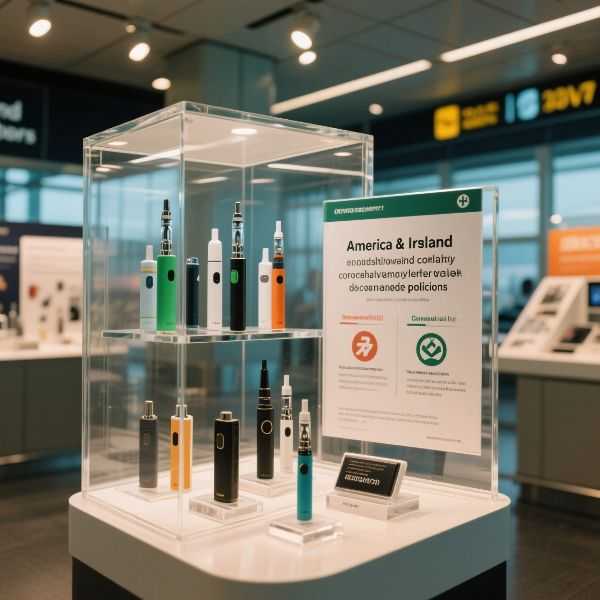Harm of vapes: Health risks that cannot be ignored
The fashionable appearance and alluring taste of vapes have made them popular, but beneath the seemingly harmless smoke lies the harm of vapes that cannot be ignored. Although often promoted as safer than traditional cigarettes, the truth is much more complicated and worrying. Understanding these vape hazards is crucial for protecting the health of oneself and those around.

The basis for understanding the harm of vapes
Vapes generate aerosols by heating e-liquid for inhalation. This is not harmless water vapor. It usually contains nicotine (highly addictive, especially harmful to the brains of teenagers), propylene glycol and vegetable glycerin (which may produce harmful substances when heated), fragrances (inhalation safety is unknown, some can decompose into toxins), heavy metals (from heating coils), as well as carcinogenic volatile organic compounds such as formaldehyde and ultrafine particles that can penetrate deep into the lungs. These are all the main components that constitute the harm of vapes.
The risk of lung damage caused by vapes
The lungs are the first to suffer from the harm of vapes. Inhaled aerosols can cause serious lung diseases such as vape-associated lung injury (EVALI, which can be fatal). Although it is related to specific additives, the risk of inhaling unknown substances always exists. Some flavorings have caused “popcorn lung” (bronchitis), and even with reduced use, similar risks still exist. The harm of vapes also aggravates asthma or increases the risk of illness, causes chronic inflammation and functional decline in the lungs, and damages the lung’s clearance function, making people more prone to respiratory infections, including influenza and COVID-19.

Vapes pose a threat to cardiovascular health
Nicotine is the main cause of cardiovascular harm from vapes. It will immediately raise heart rate and blood pressure, increasing the burden on the heart. Studies show that even short-term use of vapes can lead to arteriosclerosis and impaired vascular endothelial function, which are precursors to heart disease and stroke. The harms of vapes also include an increased risk of blood clots and triggering systemic oxidative stress and inflammation that further damage blood vessels.
The harm of vapes affects overall health
The harm of vapes goes far beyond the lungs and heart. It causes dry mouth, inflamed gums, increases the risk of tooth decay and damages oral health. For teenagers, nicotine seriously harms brain development and affects attention and emotional control. The harm of vapes may also suppress the function of the immune system, increase the risk of infection and potential cancer. Although long-term carcinogenic data are not yet complete, inhalation of known carcinogens and ultrafine particles poses a clear risk. In addition, accidental ingestion of e-liquid and battery explosion are also acute hazards of vapes.
The special vape hazards faced by teenagers
Teenagers’ brains are more sensitive to nicotine and more prone to addiction, which in itself is a major hazard of vapes. Young people who use vapes are more likely to switch to traditional cigarettes, magnifying health risks. Nicotine can also exacerbate symptoms of depression and anxiety and may hinder brain development, leading to long-term cognitive behavioral problems. This is the most alarming vape hazard for this group.
The Hazards of vapes: Reduced Harm or New Threat?
Some people think that vapes are a safer choice for adult smokers who cannot quit smoking, but this does not mean they are harmless. The aforementioned hazards of vapes still exist. Many people are exposed to the double harm of using both vapes and cigarettes at the same time. The history of vapes is relatively short, and the long-term health risks they pose decades later (such as cancer and chronic obstructive pulmonary disease) remain unknown. It is important to note that vapes are not an officially recommended method for quitting smoking. Proven safe and effective smoking cessation methods (such as counseling, nicotine replacement therapy, and prescription drugs) do not involve the harm of vapes.
Reducing the harm of vapes: Quitting smoking is the only option
The most effective way to eliminate the harm of vapes is to quit smoking completely. Seek medical help to discuss a smoking cessation plan (medication combined with behavioral counseling has a higher success rate). Make use of free resources such as smokefree-.gov, the Quit smoking hotline (1-800-QUIT NOW), or the Truth Initiative for young people (text DITCHVAPE to 88709). Identify the triggers, formulate a response plan, seek support from relatives and friends, and eliminate all vape products. Quitting smoking is challenging, but the withdrawal symptoms will subside. Persistence is the key.
Conclusion: Face up to the reality of the harm caused by vapes
The appeal of vapes masks the harsh reality: the harm of vapes is significant and still emerging. From lung damage, cardiovascular problems to impaired brain development in teenagers and potential cancer risks, scientific evidence is sufficient to serve as a warning. Although the long-term impact requires time to observe, the existing evidence already demands that we be highly cautious.
The view that vapes are harmless or absolutely safer than cigarettes is a dangerous misunderstanding. The use of vapes poses a brand-new health threat to non-smokers, especially teenagers. Smokers should choose proven methods of quitting smoking that are free from the harm of vapes. Protecting your health requires seeing the truth behind the smoke, recognizing the risks and taking active actions. Your future health is worth safeguarding.


8on87o